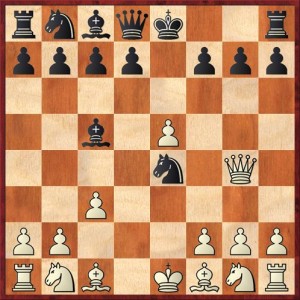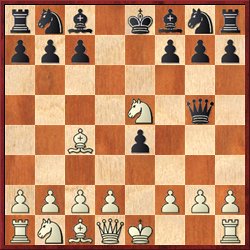Recently Gjon Feinstein showed me a Paul Morphy game that he had recently shown to his students. Like so many of Morphy’s games, it was short and sweet.
Paul Morphy — Bottin, Paris 1858
1. e4 e5 2. c3?! (Pretty unconventional by modern standards) 2. … Nf6 3. d4 Nxe4 4. de Bc5 5. Qg4!?
Here Black got too greedy, playing 5. … Nxf2? and was swiftly punished by 6. Qxg7 Rf8 7. Bg5 f6 8. ef Rxf6 9. Bxf6 Be7 10. Qg8+ and Black resigned.
If you’re curious, Black should have played 5. … Bxf2+! 6. Ke2 d5 7. Qxg7 Rf8, when it’s still a game. Really in the diagrammed position Black should not lose by force, because he has actually violated fewer opening precepts than White (Morphy) has.
One thing that struck me in this game was that Morphy’s second move, 2. c3, actually played no role in the rest of the game. So in fact this position could very well arise with colors reversed in the Elephant Gambit (also known as the Queen Pawn Counter Gambit):
1. e4 e5 2. Nf3 d5?! 3. Nxe4 de 4. Bc4 Qg5?!
Look familiar? It’s just our first diagram with colors reversed, and the pawn on c7 instead of c6 (which makes little to no difference).
I got into ChessBase and searched for this position. It turns out that this is still a topical position that has appeared about 100 times in the database. Here 5. Bxf7+ is the most popular move for White but it only scores 47%.
But when did this position first appear? The answer to that question came as a little surprise: It was first played in 1855, three years before the Morphy game! Not only that, the game was really more remarkable than the Morphy game.
Max Lange – NN, 1855:
(Begin at diagram 2.) 5. Nxf7? (That’s right, Lange blundered.) Qxg2 6. Qh5! (If you’re going to go down, at least go down swinging.) Qxh1+ 7. Ke2 Qxc1?
Here “NN” could have played 7. … Qf3+ 8. Qxf3 ef+9. Kxf3 Nf6 etc. Though Black temporarily goes down a pawn, White’s knight is not likely to survive after 10. Nxh8 Bg4+ followed by … Bh5.
But that’s not the way they played in the 1850s. They grabbed material and held on for dear life. The rest of the game is a massacre. Black massacres all of White’s pieces, and White massacres Black’s king.
8. Nd6+ Kd7 9. Qf7+ Kxd6 10. Nc3! Qxa1 11. Nxe4+ Ke5 12. Qd5+ Kf4 13. Qg5+ Kxe4 14. d3+ Kd4 15. Qe3 mate
You’ve got to see the final position to believe it.
Lange has sacrificed two rooks and three minor pieces. However, all of that extra material of Black’s is sitting back on the first rank, untouched! The only pieces Black moved in the whole game were his queen and his king. This would be a great teaching example on the theme “If you don’t use it (your material), you’ll lose it (the game).”
Now here’s a tantalizing historical question: Did Morphy know about this game? It’s tempting to think that he saw it, realized that NN’s idea of 4. … Qg5 was actually playable in spite of the debacle in this game, and decided to play it with colors reversed. Is it even possible that he prepared this opening for use against Max Lange?
If the Internet had been around in the 1850s, the answer would almost surely be “yes.” But in that era, information moved a lot slower, so who knows? I’ll leave it as a puzzle for the historians to figure out.
By the way, this little bit of research has gotten me interested in the Elephant Gambit. The conventional wisdom is that it’s just unsound, that White can just grab the pawn and defend everything. In 1997 Tim Harding wrote, “If you are a very good tactician, then the Elephant Gambit is just about playable below master level, even in correspondence chess, so long as you accept that once in a while you will be mercilessly smashed by somebody who has met it before and done research on it.”
But I wonder if this assessment is still true. I think that the Elephant Gambit may even be playable (or “just about playable”) on the master level too. When I got on ChessBase and looked up the main lines, I saw masters all the way up to the 2500 rating level playing it and not getting punished. I wonder if it’s time to give this maligned gambit (1. e4 e5 2. Nf3 d5) a little bit more respect. Maybe it would help if we gave it a new name … something that would not sound as comical as Elephant Gambit… How about Morphy Gambit?






{ 3 comments… read them below or add one }
Hi Dana,
I experimented with the Elephant Gambit in the summer of 2010, before I started playuing the San Jose Defense (1. e4 a6 2. d4 c5). My record with the gambit was 6-1 with 3 draws. I eventually had to give it up; I was struggling against players 500 points below my rating. If you want to see the games, with notes, visit my chess page here:
http://www.cob.sjsu.edu/splane_m/chess/chesspage.htm
My time learning this line wasn’t completely wasted; I got to play the White side against Hernang Jangle and won a nice miniature: http://www.cob.sjsu.edu/splane_m/chess/Jangle.htm
I have become interested in it also, after reading Phillip Corbin’s “Calypso Chess”:
http://kenilworthian.blogspot.com/2012/08/brief-review-of-calypso-chess.html
You and your readers may be interested in my recent bibliography on The Elephant Gambit:
http://kenilworthian.blogspot.com/2012/12/elephant-gambit-c40-bibliography_12.html